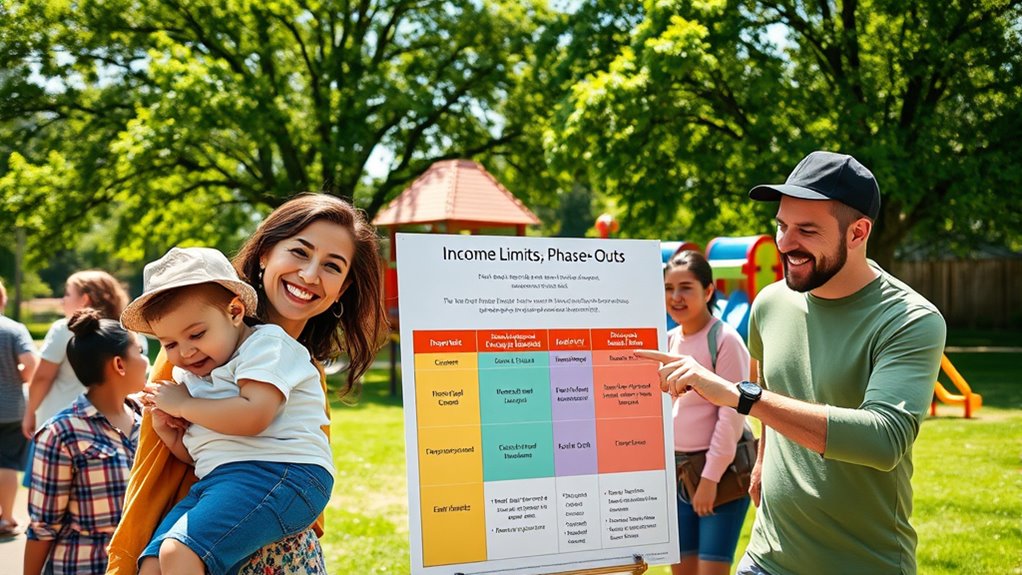To understand the Child Tax Credit boost, you need to know who qualifies, including children under 17 who live with you and have SSNs. Your income and filing status affect how much you can get and if it’s phased out. Make certain your child’s details and support info are accurate when you claim. Staying informed about recent policy updates and keeping proper documentation can help guarantee your claim is approved. Learn more about these key points ahead.
Key Takeaways
- Ensure your child meets IRS age, relationship, residency, and SSN requirements to qualify for the boosted Child Tax Credit.
- Income limits and phase-out thresholds vary; full credits are available for incomes below specific levels, with gradual reductions above.
- Gather essential documentation like SSNs, proof of residency, and support details when claiming the credit on your tax return.
- Residency and support rules include temporary absences and support contributions, affecting eligibility for children born or deceased during the year.
- Verify all personal and dependent information, keep records, and consult IRS resources or professionals to ensure claim accuracy and compliance.
Eligibility Criteria for the Child Tax Credit Boost

To qualify for the Child Tax Credit Boost, your child must meet specific eligibility criteria. First, they need to be under 17 at the end of the tax year and be claimed as a dependent, which includes children, stepchildren, foster children, or descendants like grandchildren, nieces, or nephews. They must also live with you for more than half the year, with some exceptions for temporary absences. You’re responsible for providing more than half of their financial support, ensuring they aren’t self-supporting over 50%. Additionally, your child must be a U.S. citizen, U.S. national, or U.S. resident alien, with a valid Social Security number issued before the tax deadline. Proper tax documentation, including proof of dependency, residency, and citizenship, is necessary to establish eligibility for the credit. The child’s Social Security number must be valid and issued before the deadline, as required by law. Maintaining accurate records of dependency and residency is also crucial for verifying eligibility during tax time.
Understanding Income Limits and Phase-Outs

Understanding income limits and phase-outs helps you see who qualifies for the full child tax credit. If your income exceeds certain thresholds, your credit amount gradually decreases. Knowing how the phase-out works can help you plan your taxes and maximize your benefits. Additionally, being aware of the financial affidavit requirements during divorce proceedings can help ensure accurate reporting of your financial situation, which may impact your eligibility and benefits.
Income Thresholds Explained
Have you ever wondered how income limits determine your eligibility for the Child Tax Credit? Your tax planning and income documentation play key roles here. To qualify for the full credit, single filers with one child need to earn at least $28,700, while joint filers require $36,500. These thresholds increase with more children. The phase-out begins at specific income levels: $200,000 for single filers and $400,000 for married couples filing jointly. Above these amounts, the credit reduces by $50 for every additional $1,000 earned. Additionally, there’s a minimum earnings requirement of $2,500, with the credit phased in at 15% of income above that. Understanding these income thresholds helps you plan effectively and ensure your income documentation accurately reflects your earnings. Awareness of home furnishings safety features can also help ensure comfort and safety in your living environment.
Phase-Out Process Details
The Child Tax Credit (CTC) begins to phase out once your Modified Adjusted Gross Income (MAGI) exceeds certain thresholds, which depend on your filing status. For 2024 and 2025, the phase-out starts at $200,000 for single filers and $400,000 for married filing jointly. As your income surpasses these limits, the credit reduces by $50 for every additional $1,000 of income, based on tax filing data. Income verification is essential during this process, as the IRS uses your tax return information to determine your eligibility and the reduced credit amount. Errors in reporting income can delay your claim or disallow the credit altogether. This phased reduction ensures benefits target middle- and lower-income families while limiting support for higher earners. Monitoring changes in income and understanding signs of spoilage in documents can help prevent delays or issues with your claim.
Identifying Qualified Dependents

How can you determine if someone qualifies as a dependent for the Child Tax Credit? First, review the IRS rules for dependent eligibility, which include criteria for a qualifying child or relative. Dependents must be U.S. citizens, nationals, resident aliens, or residents of Canada or Mexico. To verify, consider alternative documentation like birth certificates, Social Security numbers, or residency proof. Here’s a quick overview:
| Dependents Type | Age & Relationship | Residency & Support |
|---|---|---|
| Qualifying Child | Under 19, full-time student, disabled | Lives with you > half the year |
| Qualifying Relative | No qualifying child, supports, under $5,050 income | Lived with you or related |
| Citizenship Status | U.S., Canada, or Mexico residents | Meets residency criteria |
| Filing Status | Cannot file jointly or claim as dependent | Confirm no joint return filed |
| Documentation Needed | Birth certificates, SSNs, alternative docs | Verify under dependent eligibility |
Additionally, eligibility for the Child Tax Credit depends on meeting all these criteria and proper documentation, which ensures you maximize your potential benefits. Ensuring compliance with eligibility requirements can help prevent delays in processing your claim.
Residency and Support Requirements

Wondering if your child qualifies for the Child Tax Credit? Residency and support requirements are key. Your child must have lived with you for more than half the year, with exceptions for temporary absences like school or medical care. If a child was born or died during the year, they qualify if they lived with you for most of their life or time alive. Foster or adopted children are eligible if they lived in your home for over half the year since placement. Grandparent support can count if they provide more than half of the child’s financial needs, but proper residency documentation is essential. Special cases, like joint custody or temporary institutionalization, may also affect eligibility. Always keep records to prove residency and support for IRS review. Additionally, understanding the contrast ratio of your projector can significantly enhance your home cinema experience by providing deeper blacks and brighter whites.
Citizenship and Social Security Number Necessities

To qualify for the Child Tax Credit, your child must have valid citizenship documentation or a Social Security Number (SSN) issued by the SSA. The IRS requires both the child’s and your SSNs to process your claim, and without them, you’re ineligible. Ensuring these documents are current and accurate is essential to avoid delays or denial of the credit. Additionally, the new legislation imposes a strict SSN requirement on all claimants, which could further restrict eligibility for many families. Proper privacy policies are important to understand how your personal information is handled during this process.
Valid SSN Requirement
Are you aware that having a valid Social Security Number (SSN) is essential for claiming the Child Tax Credit in 2025? The IRS requires SSN verification to confirm your child’s eligibility, ensuring they’re a U.S. citizen, national, or resident alien. An ITIN isn’t accepted for claiming the credit. The child’s SSN must be valid for the entire tax year, and residency in the U.S. for at least six months is also necessary. For immigrant families, the immigration status impacts eligibility because only those with valid SSNs can qualify. The IRS uses SSNs to verify dependent identities and prevent fraud, making sure only eligible families claim the credit. Without a valid SSN, your claim will be denied, emphasizing the importance of proper documentation for eligibility verification. Proper documentation ensures eligibility and helps avoid delays or denial of benefits.
Citizenship Status Needed
Starting in 2025, you must guarantee that both the child and at least one parent or guardian have valid Social Security Numbers (SSNs) to qualify for the Child Tax Credit. This citizenship and SSN requirement tightens eligibility, especially affecting immigrant families and child sponsorship situations. Families with mixed statuses—where adults have ITINs instead of SSNs—typically cannot claim the credit, even if children have SSNs. This rule aligns with stricter immigration policies aimed at limiting benefits to U.S. residents. Here’s a quick overview:
| Citizenship & SSN Requirement | Impact on Families |
|---|---|
| Child must be a U.S. citizen or resident alien | Excludes many immigrant families |
| Adults must have valid SSNs | Limits access for those with ITINs |
| Verification via IRS records | Affects mixed-status households |
Additionally, immigration status plays a significant role in determining eligibility for the credit.
How to Claim the Child Tax Credit

Wondering how to claim the Child Tax Credit? First, gather your child’s Social Security Number (SSN), proof of residency like school or medical records, and income statements such as W-2 or 1099. When filing, use Form 1040 and attach Schedule 8812 to determine any refundable portion. You can file electronically with reputable software, which simplifies entering details about childcare options and educational expenses that may qualify for additional credits. If your income qualifies, IRS Free File offers free options. Be sure to use direct deposit for faster refunds. Accurate completion is essential—errors can delay or deny your claim. Remember, proper documentation supports your eligibility, so keep everything organized. Filing correctly ensures you get the maximum benefit from your child’s credits and expenses. Regularly reviewing the Child Tax Credit benefits can help you stay informed about any updates or changes to the program.
Impact of Filing Status and Support Contributions

Your filing status plays a significant role in determining both your eligibility for the Child Tax Credit and the amount you can claim. It affects income limits, phaseout thresholds, and refundability. Here’s what you need to know:
Your filing status influences your Child Tax Credit eligibility, phaseouts, and refundability considerations.
- Filing status impacts income thresholds for phaseouts—married filing jointly allows higher limits, while filing separately drops the limit to $55,000.
- Support contributions matter; you must provide over half the child’s support, including food, shelter, and medical care, to qualify.
- Child support arrangements influence who can claim the credit, especially in divorced or separated situations, depending on custodial support and residency.
Understanding these factors helps ensure you maximize your Child Tax Credit benefits without risking IRS penalties.
Recent Changes and Policy Updates

Recent policy updates have markedly reshaped the Child Tax Credit landscape for 2025, with new income thresholds and phase-out rules. If you’re a married couple filing jointly, the full credit is available for incomes below $150,000, but begins to phase out starting at $400,000. For single filers, full benefits start below $75,000, phasing out at $200,000. The rules around childcare expenses have expanded, including more relatives like stepchildren and foster children. Be aware of tax filing deadlines, as the IRS may delay refunds to verify claims and prevent fraud. These updates also reinforce residency and citizenship requirements, ensuring only eligible children claim the credit. Staying informed helps you maximize benefits while meeting all current regulations.
Tips for Ensuring Your Claim Is Approved

To make certain your Child Tax Credit claim gets approved, focus on meeting all eligibility requirements and submitting accurate information. Here are three tips to help you succeed:
- Verify your child’s eligibility, including age, relationship, residency, and Social Security number, ensuring no issues with child support or support claims.
- Gather proper tax documentation, such as proof of residency, financial support, and supporting documents for any child support payments made.
- Double-check all personal information, especially Social Security numbers and income details, to prevent delays or denials. Using IRS tools and consulting a tax professional can also increase your chances of approval. Keeping accurate records and timely reporting changes guarantees your claim moves smoothly through IRS review processes.
Frequently Asked Questions
Can Non-Custodial Parents Qualify for the Child Tax Credit Boost?
You can qualify for the child tax credit boost as a non-custodial parent if you meet specific criteria related to custodial rights and parental residency. If the child lived with you more than half the year, and you have a formal agreement or IRS form waiving custodial rights, you may claim the credit. Proper documentation and understanding parental residency rules are essential to maximize your benefits legally.
What Happens if My Child Has Dual Citizenship?
Dual citizenship is like holding a key to two worlds, opening doors in both countries. If your child has dual citizenship, you must consider international considerations, especially for tax purposes and documentation. Guarantee your child has a valid U.S. Social Security Number and proper proof of citizenship. Stay aware of legal responsibilities in both nations, and keep detailed records to support your Child Tax Credit claim, avoiding potential legal or tax complications.
Are Foster Children Automatically Eligible for the Credit?
Foster eligibility doesn’t mean automatic qualification for the Child Tax Credit. You must meet specific criteria, like the child being under 17, placed with you by a court or authorized agency, and living with you for over half the year. You also need to provide more than half of their support and have a valid Social Security number. Only then can you claim the credit, as foster children aren’t automatically eligible.
How Does the Child Tax Credit Affect Other Benefits?
Think of the Child Tax Credit as a ripple in your benefits pond. It typically doesn’t drown out your eligibility criteria for programs like SNAP or Medicaid, but benefit coordination matters—some benefits might see it as unearned income, affecting calculations. While it usually won’t cut your benefits, understanding how the CTC interacts with your income helps you stay afloat and avoid surprises when eligibility thresholds are in reach.
Can I Claim the Credit if I Didn’t Provide Support?
You can’t claim the Child Tax Credit if you didn’t provide custodial support or lack legal guardianship. The IRS requires you to have provided over half of the child’s financial support and to have shared custody or guardianship. If another caregiver or relative provided the support, they might qualify instead. Remember, the child must live with you more than half the year, and you must meet the other eligibility criteria.
Conclusion
Now that you know what’s required to claim the child tax credit boost, don’t wait too long. There’s more at stake than just extra money—your eligibility could change with recent policy shifts. Are you fully prepared to navigate the process and secure your benefits? Stay informed, double-check your details, and act quickly—because missing out could mean leaving money on the table when you need it most. The next move is yours.









